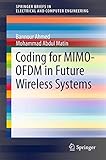Coding for MIMO-OFDM in Future Wireless Systems [electronic resource] / by Bannour Ahmed, Mohammad Abdul Matin.
By: Ahmed, Bannour [author.].
Contributor(s): Abdul Matin, Mohammad [author.] | SpringerLink (Online service).
Material type: BookSeries: SpringerBriefs in Electrical and Computer Engineering: Publisher: Cham : Springer International Publishing : Imprint: Springer, 2015Description: XIII, 88 p. 35 illus., 16 illus. in color. online resource.Content type: text Media type: computer Carrier type: online resourceISBN: 9783319191539.Subject(s): Engineering | Information storage and retrieval | Electrical engineering | Engineering | Communications Engineering, Networks | Information Storage and RetrievalAdditional physical formats: Printed edition:: No titleDDC classification: 621.382 Online resources: Click here to access online
BookSeries: SpringerBriefs in Electrical and Computer Engineering: Publisher: Cham : Springer International Publishing : Imprint: Springer, 2015Description: XIII, 88 p. 35 illus., 16 illus. in color. online resource.Content type: text Media type: computer Carrier type: online resourceISBN: 9783319191539.Subject(s): Engineering | Information storage and retrieval | Electrical engineering | Engineering | Communications Engineering, Networks | Information Storage and RetrievalAdditional physical formats: Printed edition:: No titleDDC classification: 621.382 Online resources: Click here to access online Overview of MIMO-OFDM -- Wireless channels -- Code Design For MIMO-OFDM System -- Algebraic Space-Time (ST) Codes: an Overview -- ASTC-MIMO to ASTC-MIMO-OFDM System -- Space Time Frequency (STF) for Multiuser MIMO-OFDM -- General Conclusion.
This book introduces the reader to the MIMO-OFDM system, in Rayleigh frequency selective-channels. Orthogonal frequency division multiplexing (OFDM) has been adopted in the wireless local-area network standards IEEE 802.11a due to its high spectral efficiency and ability to deal with frequency selective fading. The combination of OFDM with spectral efficient multiple antenna techniques makes the OFDM a good candidate to overcome the frequency selective problems.


There are no comments for this item.